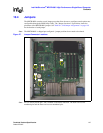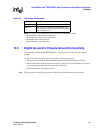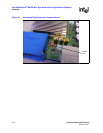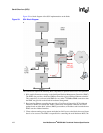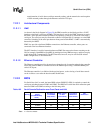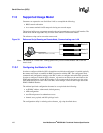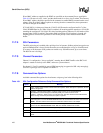
154 Intel NetStructure
®
MPCBL0001 Technical Product Specification
Serial Over Lan (SOL)
From the table above, the serial over LAN can only be activated if a user configures the BIOS
correctly. By default, the console redirection setting is enabled and the SOL support is set to
“Disabled”.
If a user has a serial session active via the front panel and a user initiates a SOL session on this
blade, the serial data on the front panel will be deactivated automatically. The serial data will be
sent via the LAN interface to the SOL client system. On the serial console connected to the front
panel, the BIOS will send the message “Serial Over LAN session is active” to inform the active
user that the serial data has been switched.
11.3 Theory of Operation
11.3.1
Front Panel Serial Port
By default, the serial console data will be connected to the front panel.
11.3.2 Serial Over LAN
The SOL feature is disabled by default at manufacturing time. A user needs to configure the
relevant SOL settings using the reference_cfg script supplied in the IPMC Firmware 1.17 release
package (downloadable from this website under “Software Downloads”: http://support.intel.com/
support/network/computeboards/mpcbl0001).
With the reference_cfg file, a user can use this script to configure the serial port settings (baud rate,
parity bits, data bits, stop bits, flow control), user name and password for RMCP+ sessions. Refer
to Section 11.6.1, “SOL Configuration Reference Script (reference_cfg)” on page 157 for further
details on this script
The IP address to be used by IPMC can be configured at initial setup of the blade in the system.
The IP address, once configured, is stored in a non-volatile memory and is persistent across IPMC
update and payload resets. IP addresses are assigned to the IPMC independently of the host (OS) IP
addresses and they need not match. IP addresses used by the OS are not visible to the IPMC.
To start SOL communication, the user invokes the SOL client utility with the IP address of the
blade and a series of authentication parameters (username, password, privilege level, cipher suite,
etc). The IPMI v2.0 specification allows for AES encryption algorithms for encryption of payload
data sent over the network, including AES-128, which uses 128-bit cipher keys.
The SOL client utility initializes a RMCP+ session with the blade and activates SOL. When
authentication is successfully completed, IPMC firmware collects serial port data from the blade’s
serial port, formats it into network packets, and forwards it to the SOL client utility over the SOL
session. The SMBus TCO port between the IPMC and base interface Ethernet controller is used for
this purpose. The SOL client utility receives the packets, extracts the serial port data, and displays
it on the screen. The IPMC extracts the serial port data received from the SOL client utility and
writes it to the serial port of the blade. This allows network redirection of blade’s serial port data
stream independent of the host OS or BIOS. The Ethernet controller plays a critical role in
redirecting the packets meant for the IPMC, based on receive filters.




